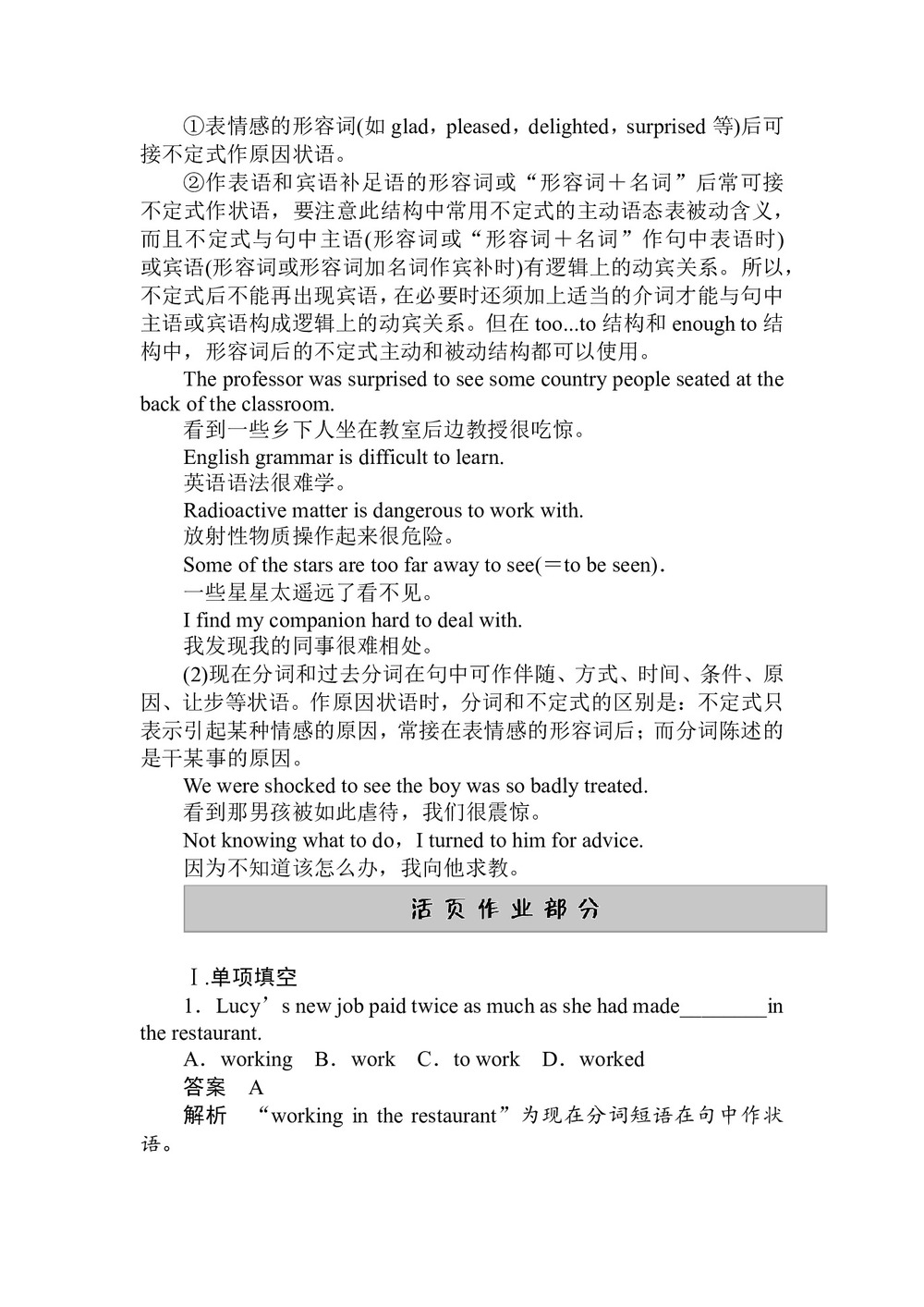
①表情感的形容词(如glad,pleased,delighted,surprised等)后可接不定式作原因状语。
②作表语和宾语补足语的形容词或"形容词+名词"后常可接不定式作状语,要注意此结构中常用不定式的主动语态表被动含义,而且不定式与句中主语(形容词或"形容词+名词"作句中表语时)或宾语(形容词或形容词加名词作宾补时)有逻辑上的动宾关系。所以,不定式后不能再出现宾语,在必要时还须加上适当的介词才能与句中主语或宾语构成逻辑上的动宾关系。但在too...to结构和enough to结构中,形容词后的不定式主动和被动结构都可以使用。
The professor was surprised to see some country people seated at the back of the classroom.
看到一些乡下人坐在教室后边教授很吃惊。
English grammar is difficult to learn.
英语语法很难学。
Radioactive matter is dangerous to work with.
放射性物质操作起来很危险。
Some of the stars are too far away to see(=to be seen).
一些星星太遥远了看不见。
I find my companion hard to deal with.
我发现我的同事很难相处。
(2)现在分词和过去分词在句中可作伴随、方式、时间、条件、原因、让步等状语。作原因状语时,分词和不定式的区别是:不定式只表示引起某种情感的原因,常接在表情感的形容词后;而分词陈述的是干某事的原因。
We were shocked to see the boy was so badly treated.
看到那男孩被如此虐待,我们很震惊。
Not knowing what to do,I turned to him for advice.
因为不知道该怎么办,我向他求教。
Ⅰ.单项填空
1.Lucy's new job paid twice as much as she had made________in the restaurant.
A.working B.work C.to work D.worked
答案 A
解析 "working in the restaurant"为现在分词短语在句中作状语。
2.Ideally ________ between Broadway Theatres and Fifth Avenue
-
相关教案下载
- 12019-2020学年度人教版必修五Unit 3 Life in the futurePeriod 3Learning about Language学案(7页word版)
- 22019-2020学年度人教版必修五Unit 3Life in the futurePeriod 5Using Language教案(11页word版)
- 32019-2020学年度人教版必修五Unit 3Life in the future Period 3 Learning about language教案(25页word版)
- 42019-2020学年度人教版必修五Unit 3 Life in the futurePeriod3Learning about language教案(5页word版)
- 52019-2020学年度人教版必修五Unit 3 Life in the futurePeriod3Learning about language 学案(17页word版)
- 62019-2020学年度人教版必修五Unit 3 Life in the futurePeriod3Learning about language学案(6页word版)
- 72019-2020学年度人教版必修五Unit 3 Life in the futurePeriod3Learning about language学案(6页word版)(1)
- 82018-2019学年度人教版必修五Unit 3 Life in the futurePeriod 3Learning aboutlanguage教案设计(6页word版)
- 92019-2020学年度人教版必修五Unit 2 The United Kingdom Period 3Learning about language教案(30页word版)